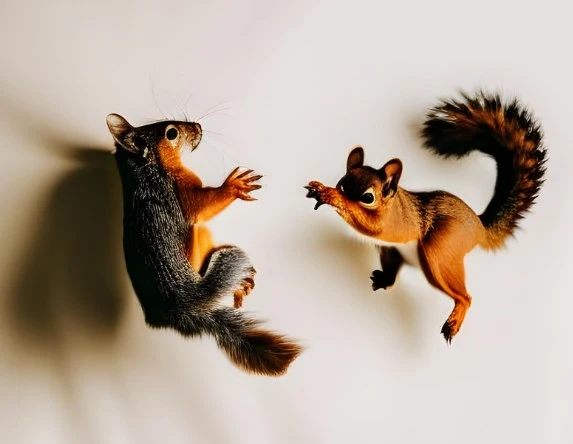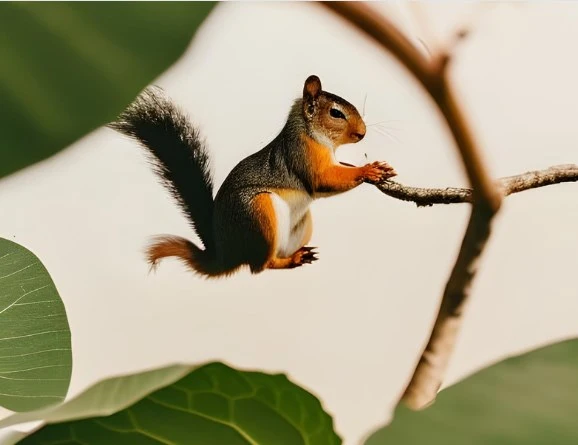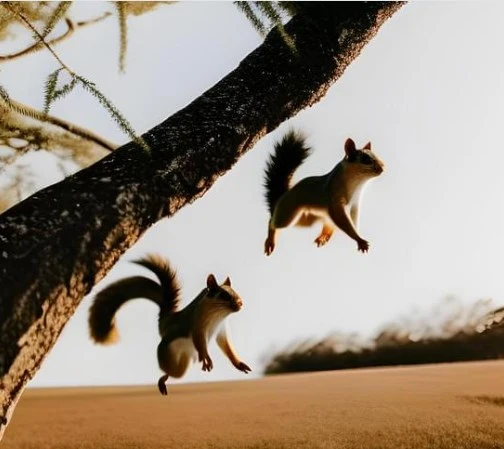Why Do Squirrels Chase Each Other? Have you ever looked out your window and seen squirrels darting around, chasing each other up and down trees? It’s a common sight in many neighborhoods. But have you ever wondered why they do it? Well, today we’re going to explore the reasons behind this playful behavior.
First of all, it’s important to know that not all squirrel chases are just for fun. Sometimes male squirrels will chase females as part of their mating rituals. But when you see two or more squirrels chasing each other through the branches, it’s usually because they’re playing. Just like kids on a playground, squirrels love to play games with each other. They might be trying to show off their agility and speed, or maybe they’re just enjoying themselves. Either way, watching them can be quite entertaining!
Playful Behavior In Squirrels
Squirrels are fascinating creatures that can be found in many parts of the world. One interesting behavior they exhibit is playfulness. They often chase each other around, jumping and climbing trees with great agility.
This playful behavior has evolutionary significance as it helps young squirrels develop important skills such as balance, coordination, and social interaction. Through play, squirrel pups learn how to navigate their environment and communicate with others. It also helps them build muscle and endurance for survival in the wild.
Communication methods among squirrels include vocalizations like chirps, barks, and squeaks, as well as body language such as tail flicking and ear movements. Playful chasing may also serve a communicative purpose between squirrels by conveying messages about dominance or territorial boundaries. Overall, this playful behavior showcases the intelligence and adaptability of these small but mighty creatures.
As male squirrels grow older, their behaviors shift towards mating rituals which involve elaborate displays of physical prowess to attract mates.
Mating Rituals In Male Squirrels
Male squirrels engage in a variety of behaviors during mating season, including chasing each other. This behavior is triggered by hormonal impulses that drive male squirrels to compete for female attention. Male squirrels chase each other as part of their competition dynamics, trying to prove themselves as the more dominant and attractive mate.
Hormonal triggers play a significant role in male squirrel behavior during mating season. Testosterone levels increase dramatically, leading to an increase in aggressive behaviors like chasing and fighting. As males compete for access to females, they will often engage in these behaviors with one another.
Competition dynamics also come into play during this time. Male squirrels not only chase each other but also engage in displays of dominance such as vocalizing or posturing to intimidate their rivals. These displays are all designed to impress potential mates and demonstrate superiority over competitors.
- Males may use scent marking to establish territory
- Vocalizations can be used both aggressively and attractively
- Physical displays like tail flicking or standing on hind legs show off strength and agility
- Chasing and wrestling matches determine which males are the most fit for reproduction
Social interactions among squirrels are just as fascinating as their mating rituals.
Social Interactions Among Squirrels
Have you ever seen squirrels chasing each other in the park or on your backyard trees? It’s quite a sight to see! Squirrels are social animals that engage in various behaviors, including playing and interacting with one another. However, some of these interactions can also involve aggressive behavior.
One reason why squirrels may chase each other is due to territorial disputes. Like many animals, squirrels have designated areas where they store their food and raise their young. When another squirrel enters this territory, it can lead to conflict between them as they try to defend their space. This often results in chases around the area until one squirrel gives up and retreats.
Aggressive behavior isn’t always the cause of chasing among squirrels. Sometimes, it’s just playful behavior that helps them build strong social bonds. Younger squirrels are more likely to engage in play-chasing than adults who tend to stick more closely to defending their territories. These playful chases help younger squirrels develop important skills like displaying agility and speed necessary for survival later on.
Speaking of agility and speed, did you know that squirrels can run up to 20 miles per hour? In the next section, we’ll take a closer look at how these furry creatures use their impressive abilities to maneuver through trees and avoid predators while displaying remarkable feats of acrobatics!

Displaying Agility And Speed
Have you ever seen squirrels chasing each other? It looks like they are playing a game of tag! Squirrels are very agile and quick, which makes them excellent at tree leaping. When they chase each other, it’s not just for fun – it’s also to train their skills.
Squirrels need to be able to gather nuts quickly in order to survive. By practicing their speed and agility through games of chase, they become better hunters. They can jump from branch to branch with ease and catch prey faster than slower animals.
Next time you see squirrels chasing each other, remember that they’re not just having fun – they’re sharpening their survival skills! And if you want to practice your own agility and speed, try playing games on the playground. It’s a great way to stay active while having fun with friends.
Playing Games On The Playground
After displaying their agility and speed, squirrels often engage in imaginative play with each other. One common game they like to play is chasing each other around trees and branches. This physical activity not only helps them stay active but also improves their coordination and reflexes.
During the chase, squirrels may jump from tree to tree or even run along power lines. They use their sharp claws to grip onto bark and their fluffy tails for balance. Some squirrels even make playful noises while chasing each other, adding an extra layer of fun to the game.
As they enjoy themselves in the trees, squirrels show us that physical activity can be both beneficial and enjoyable. Just like these furry creatures, we should find ways to incorporate movement into our daily routines through games and activities that challenge our bodies in a fun way.
Enjoying Themselves In The Trees – Why Do Squirrels Chase Each Other
When you look up at the trees, it’s easy to spot squirrels darting through the branches. These furry creatures are known for their tree antics and acrobatic hijinks as they chase each other around. But did you know that sometimes, squirrels aren’t just playing a game of tag?
Squirrels may also be engaging in what is called “practice play.” Just like human children who practice skills through play, young squirrels use chasing games to hone their hunting and survival instincts. It might seem like they’re simply having fun, but these playful moments are actually preparing them for adulthood.
If you ever have the chance to observe squirrels in action, pay attention to how they move. Squirrels can jump up to 10 times their body length and run along power lines without getting electrocuted! Watching them climb trees with ease or balance on a thin branch will make you appreciate the amazing abilities of these little creatures.
Markdown list: – Climbing high into the treetops – Balancing on tiny branches – Jumping from limb to limb – Running across telephone wires
As you watch squirrels enjoy themselves in the trees, remember that there’s more going on than meets the eye. While it might look like they’re just goofing off, these playful animals are practicing important life skills. Keep observing them and learning about their fascinating behaviors – who knows what else you might discover?
Observing Squirrels In Your Neighborhood
Squirrels live in lots of places, like parks and gardens. They can also live in trees in our backyards! They like to eat nuts and fruits, and they like to dig in the dirt. Squirrels like to chase each other around, or sit together in groups. They use their tails to communicate with each other, like a secret language. When they’re in groups, they’ll groom each other and play together.

Squirrel Habitats
You’re walking through your neighborhood, and you spot a few squirrels chasing each other up and down the trees. Have you ever wondered why they do this? Squirrels are fascinating creatures that can be found in many habitats across North America.
One of the most important things to understand about squirrels is their dependence on trees for their habitat. Trees provide shelter, nesting sites, and protection from predators. Without trees, squirrels would struggle to survive. That’s why it’s essential to protect our forests and plant new trees whenever possible.
Another critical aspect of squirrel habitats is food sources. Squirrels rely on nuts, seeds, fruits, and insects as their primary source of nutrition. They store food during the fall months so that they have enough to eat throughout the winter when food is scarce. By observing squirrels’ eating habits in your area, you can learn more about what types of plants and trees grow there.
In conclusion, understanding squirrel habitats can help us appreciate these cute critters even more! When we protect our environment by planting trees and conserving natural resources, we ensure that squirrels (and other wildlife) can continue to thrive for generations to come. So keep an eye out for those playful little squirrels running around your neighborhood – who knows what secrets they might reveal about their unique ecosystem!
Squirrel Behaviors
Now that we know a bit more about squirrel habitats, let’s take a closer look at their behaviors. Squirrels are social animals and use several forms of communication to interact with one another. They make different sounds like chattering or barking to signal danger or alert other squirrels in the area. Additionally, they also use body language such as tail flicking and ear positioning to express emotions.
Squirrels can be quite territorial when it comes to protecting their food sources and nesting sites. If you observe multiple squirrels in your neighborhood, you may notice them chasing each other away from certain areas. This behavior is especially common during mating season when male squirrels compete for female attention.
It’s important to note that while squirrels might seem cute and harmless, they are still wild animals and should not be approached or fed by humans. Observing their natural behaviors from a safe distance can provide insight into their unique personalities and habits. By respecting these furry creatures’ space and boundaries, we can continue to coexist peacefully with our squirrel neighbors without disrupting their environment or causing harm.
Squirrel Interactions
Have you ever seen squirrels playing in the trees around your house? It can be fascinating to watch their tree top antics as they scurry up and down branches, leaping from one to another with ease. But have you ever wondered what these furry creatures are doing up there all day? By observing squirrel interactions, we can get a glimpse into their world and learn more about how they communicate and interact with one another.
One of the most interesting things about squirrels is how territorial they can be. While they may seem cute and harmless, squirrels will fiercely defend their food sources and nesting sites against other animals – including other squirrels! If you see multiple squirrels in your neighborhood, you might notice them chasing each other away from certain areas or getting into territorial disputes. This behavior becomes especially evident during mating season when male squirrels compete for female attention.
As much as we may want to interact with these adorable critters, it’s essential to remember that they’re wild animals and should not be approached or fed by humans. Instead, observe their natural behaviors from a safe distance to gain insight into their unique personalities and habits. Take note of any signs of aggression or territoriality so that you can respect these furry creatures’ space and boundaries while enjoying watching them play in the trees.
Understanding The Fascinating World Of Squirrels
After observing squirrels in your neighborhood, it’s time to dive deeper into the fascinating world of these little creatures. One interesting behavior you may have noticed is when they chase each other around trees and across lawns. But why do they do this? Squirrels are highly social animals that engage in playful behaviors as a way of communicating with one another.
In fact, squirrel communication goes beyond just chasing each other. They also use vocalizations such as chirps, barks, and whistles to signal danger or to attract mates. Additionally, their tails play an important role in communication as well. For example, if a squirrel feels threatened or scared, it will raise its tail as a warning sign to others nearby.
Another aspect of squirrel behavior that is worth exploring is their nesting habits. Squirrels build nests called dreys out of twigs and leaves high up in trees for protection from predators and harsh weather conditions. These nests can be spotted easily by looking for clumps of leaves at the top of trees or power poles. However, squirrels don’t always choose treetops for their homes; sometimes they will nest inside tree cavities or underground burrows.
Squirrel behavior is endlessly fascinating and there’s so much more to explore beyond what we’ve covered here today. By taking the time to observe them closely and learn about their communication methods and nesting habits, we can gain a greater appreciation for these adorable little creatures who share our environment.
Frequently Asked Questions
What Do Squirrels Eat – Why Do Squirrels Chase Each Other ?
Squirrels have a very specific diet that meets their nutritional needs. They love to forage for nuts, acorns, seeds, fruits and vegetables. This is important because they need to consume foods with high amounts of protein and fat to maintain their energy levels throughout the day. When it comes to behavior, squirrels are great at nesting in trees or building homes made from twigs and leaves. They also enjoy socializing with other squirrels by grooming each other’s fur or playing games together. Overall, squirrels have unique dietary needs and behaviors that make them fascinating creatures to observe in nature!
How Long Do Squirrels Live?
Squirrels are small animals that live in trees and forests. They have bushy tails, sharp claws, and they love to eat nuts, fruits, and insects. Did you know that the average lifespan of a squirrel is about three to six years? That’s not very long! Squirrels also have interesting behavior patterns like burying their food for later and building nests out of leaves and twigs. So if you see squirrels chasing each other in the park, it’s just because they’re playing or trying to establish dominance over their territory.
What Is The Difference Between Male And Female Squirrels?
Male and female squirrels are different in their reproductive anatomy. Males have testes while females have ovaries. Squirrel behavior can also differ between males and females during mating season, with males often chasing after receptive females. However, it is important to remember that not all squirrel chases are related to reproduction, as they also engage in playful pursuits for exercise and social bonding.
How Do Squirrels Protect Themselves From Predators?
Squirrels are very skilled climbers, which helps them protect themselves from predators. They also use their tails to help with balance and communication. If a predator approaches, squirrels may stand still or freeze until the danger has passed. Additionally, they may make loud chattering noises or flick their tails rapidly as a warning signal to other squirrels in the area. These behaviors help keep squirrels safe in the wild!
What Is The Impact Of Squirrels On The Environment?
Squirrels have an ecological significance because they help spread seeds and nuts by storing them in various places. Their activities also aid in soil aeration, which benefits plants. However, squirrels can cause damage to trees by stripping bark or eating buds and flowers. Conservation efforts are being made to protect squirrel habitats and reduce the negative impact on tree populations. It is important for humans to understand the role of squirrels in the environment and take steps to preserve their presence while minimizing harm to other species.
Conclusion
So, why do squirrels chase each other? Well, it turns out that there are a few reasons! Sometimes they’re playing and having fun. Other times they might be fighting over food or territory. And sometimes male squirrels will chase female squirrels during mating season to try to win their affection.
Squirrels are fascinating creatures with unique behaviors and habits. They eat walnuts, nuts, seeds, fruits, , and even insects. Male squirrels tend to be bigger than females, but both genders have bushy tails and sharp claws for climbing trees. When they sense danger from predators like hawks or snakes, squirrels use their quick reflexes and agile bodies to escape harm’s way. Overall, squirrels play an important role in our environment by spreading seeds and helping to maintain the balance of nature.

